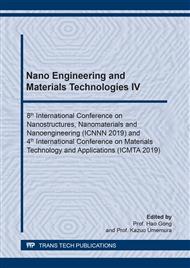[1]
WRAP, Recovered paper market: Indonesia,, The Waste and Resources Action Programme, England, (2010).
Google Scholar
[2]
C. Cara, E. Ruiz, M. Ballesteros, P. Manzanares, M. J. Negro and E. Castro, Production of fuel ethanol from steam-explosion pretreated olive tree pruning,, Fuel, vol. 87, no. 6, pp.692-700, (2008).
DOI: 10.1016/j.fuel.2007.05.008
Google Scholar
[3]
N. A. Poirier, I. I. Pikulik and R. Gooding, Papermaking,, Encyclopedia of Materials: Science and Technology, p.6739–6747, (2001).
DOI: 10.1016/b0-08-043152-6/01193-1
Google Scholar
[4]
S. W and S. IZ, Chemical Properties and Fiber Dimension of Acacia mangium Willd,, J. Tropical Wood Science and Technology, vol. 4, pp.28-32, (2006).
Google Scholar
[5]
M. Holtzapple, Cellulose,, Encyclopedia of Food Sciences and Nutrition, pp.998-1007, (2003).
Google Scholar
[6]
M. Joshi and B. Adak, Advances in Nanotechnology Based Functional, Smart and Intelligent Textiles: A Review,, Reference Module in Materials Science and Materials Engineering, (2018).
Google Scholar
[7]
I. Holme, Adhesion to textile fibres and fabrics,, International Journal of Adhesion and Adhesives, vol. 19, no. 455, (1999).
DOI: 10.1016/s0143-7496(99)00025-1
Google Scholar
[8]
G. R. Filho, S. F. da Cruz, D. Pasquini, D. A. Cerqueira, V. d. S. Prado and R. M. N. de Assunção, Water flux through cellulose triacetate films produced from heterogeneous acetylation of sugar cane bagasse,, Journal of Membrane Science, vol. 177, no. 1-2, pp.225-231, (2000).
DOI: 10.1016/s0376-7388(00)00469-5
Google Scholar
[9]
S. G and B. L, A Review on Preservation of Fruits by Sucrose Polyester Coatings,, GIDA, vol. 22, no. 3, pp.227-232, (1997).
Google Scholar
[10]
GRAS, Generally Recognized as Safe,, U.S. Food and Drug, 26 09 2018. [Online]. Available: https://www.fda.gov/.
Google Scholar
[11]
T. M. Kenan, S. W. Tannbaum and J. P. Nakas, Biodegradable polymers from renewable forest resources,, Biodegradable Polymers for Industrial Applications, p.219–250, (2005).
DOI: 10.1533/9781845690762.2.219
Google Scholar
[12]
N. E. Suyatma, Y. Ishikawa and H. Kitazawa, Nanoreinforcement of Pectin Film to Enhance its Functional Packaging Properties by Incorporating ZnO Nanoparticles,, Advanced Materials Research, vol. 845, p.451–456, (2013).
DOI: 10.4028/www.scientific.net/amr.845.451
Google Scholar
[13]
B. Hu, D.-W. Sun, H. Pu and Q. Wei, Recent advances in detecting and regulating ethylene concentrations for shelf-life extension and maturity control of fruit: A review,, Trends in Food Science & Technology, vol. 91, pp.66-82, (2019).
DOI: 10.1016/j.tifs.2019.06.010
Google Scholar
[14]
V. Singh, S. K. Jawandha, P. P. S. Gill and M. S. Gill, Suppression of fruit softening and extension of shelf life of pear by putrescine application,, Scientia Horticulturae, vol. 256, pp.1-7, (2019).
DOI: 10.1016/j.scienta.2019.108623
Google Scholar
[15]
M. Hashem, S. A. M. Alamri, M. S. A. Alqahtani and S. R. Z. Alshehri, A multiple volatile oil blend prolongs the shelf life of peach fruit and suppresses postharvest spoilage,, Scientia Horticulturae, vol. 251, pp.48-58, (2019).
DOI: 10.1016/j.scienta.2019.03.020
Google Scholar
[16]
S. Yousaf, M. A. Alhnan, A. Abdallah, B. Abdallah, I. Khan and W. Ahmed, Nanocoatings in medicine,, in Emerging Nanotechnologies for Manufacturing, United of Kingdom, William Andrew, 2015, pp.418-443.
DOI: 10.1016/b978-0-323-28990-0.00016-6
Google Scholar
[17]
V. Arole and S. Munde, Fabrication Of Nanomaterials By Top-Down And Bottom-Up Approaches – An Overview,, JAAST:Material Science, vol. 1, no. 2, pp.89-93, (2014).
Google Scholar
[18]
C. Liu and R. Bai, Preparing highly porous chitosan/cellulose acetate blend hollow fibers as adsorptive membranes: Effect of polymer concentrations and coagulant compositions,, Journal of Membrane Science, vol. 279, no. 1-2, pp.336-346, (2006).
DOI: 10.1016/j.memsci.2005.12.019
Google Scholar
[19]
R. Lestari, G. Ebert and S. Huyskens-Keil, Fruit Quality Changes of Salak "Pondoh" Fruits (Salacca zalacca (Gaertn.) Voss) during Maturation and Ripening,, Journal of Food Research, vol. 2, no. 1, pp.204-216, (2013).
DOI: 10.5539/jfr.v2n1p204
Google Scholar
[20]
M. Marpaung, U. Ahmad and N. Suyatman, Pelapis Nanokomposit untuk Pengawetan Salak Pondoh Terolah Minimal,, Jurnal Teknik Pertanian, vol. 3, pp.73-80, (2015).
DOI: 10.19028/jtep.03.1.73-80
Google Scholar
[21]
D. Lin and Y. Zhao, Innovations in the Development and Application of Edible Coatings for Fresh and Minimally Processed Fruits and Vegetables,, Comprehensive Reviews in Food Science and Food Safety, vol. 6, no. 3, pp.60-75, (2007).
DOI: 10.1111/j.1541-4337.2007.00018.x
Google Scholar


